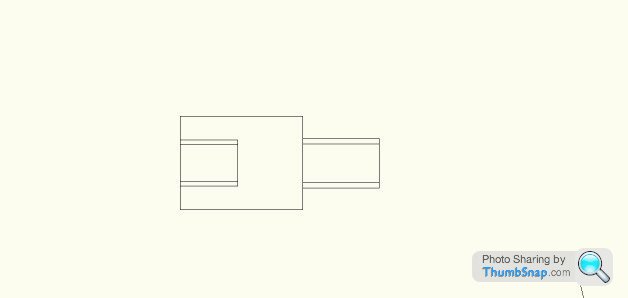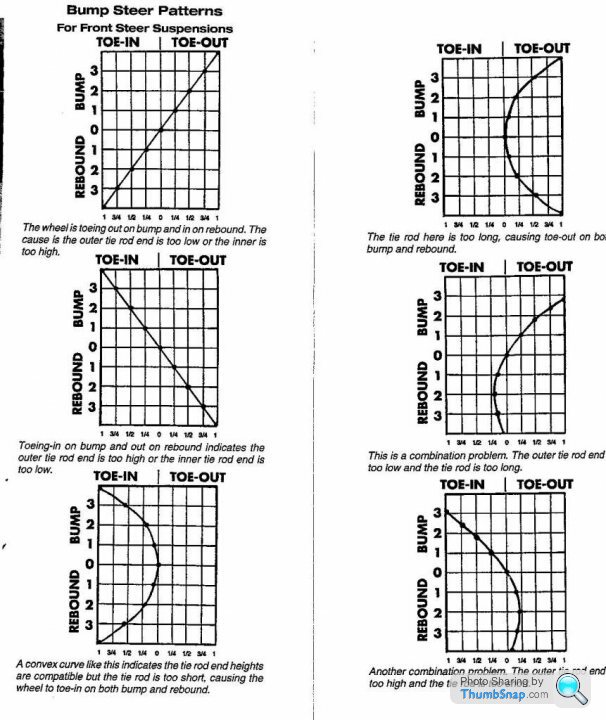Tuscan front suspension facts and experiment
Discussion
After looking at many posts on the subject of bump steer issues with the early Tuscan and having experienced first hand the effect of adding spaces to my prevous '04 Tuscan, I am now aware of the small changes that can have a massive effect on the way a car feels and steers.
For anyone wanting to know more about suspension design, I would reccoment reading "The sports car and Kit car suspension and brakes high performance manual". Its hardcore reading and takes a while to sink in. I'd also reccomend getting your hands on a remote controlled buggy so that you can play with the suspension and see the relationships and effects of different settings.
I am in the throws of rebuilding my Tuscan from the ground up:
http://www.pistonheads.com/gassing/topic.asp?h=0&a...
and the latest discussion has moved onto the suspension and whether I should change the design to the later configuration.
The research I have done shows that in march 2001 the design of the front suspension changed in the following way:
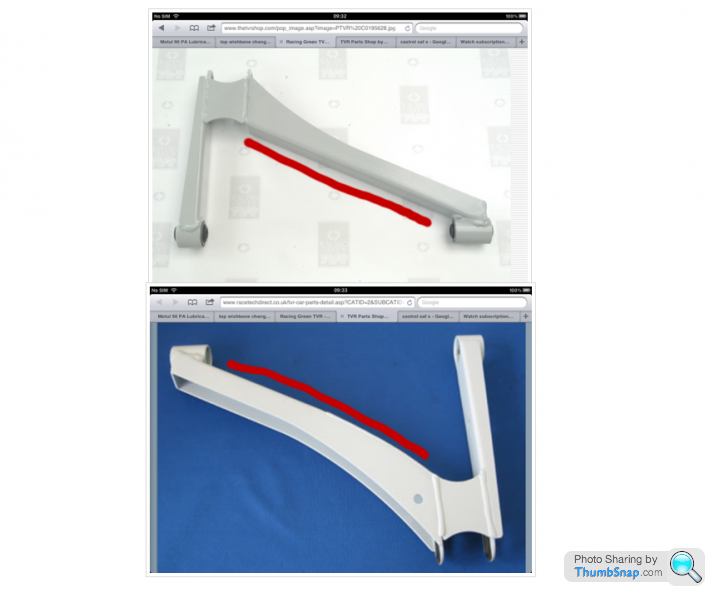
Bump steer is often refered to as "The problem with the early cars". From my dealings and involvement with the SP Wheel Spacers (I was the first person to test it), I understand that tyre wall height has an effect on the scrub radius and by either increasing the tyre wall or increasing your offset with a spacer, it is possible to alter the scrub radius.
From what I have read, the scrub radius needs to pass through the contact patch of the tyre and depending on whether it passes inboard or outboard of the centre line of the wheel, it can have an effect of pulling the wheel either outboard or inboard.
Acknowledging the above, if in addition to the scrub radius, there is an effect of bump steer that will cause the wheels to point outwards (positive toe) or inwards (negative toe), the effect can be significantly amplified.
Therefore, I set out to understand suspensions characteristics on MY CAR (Jan 2000). I can only comment on my car due to the aformentioned variables.
I set up my geometry to the following default factory settings:
I used this experimental setup/technique to measure bump steer: http://youtu.be/LO07qmJ9zkk
My videos show the standard setup, and with 4mm added beneath the steering rack.
http://youtu.be/3QKvdZWyV_I
http://youtu.be/_Yt0JcNhxOA
From what I understand, the thing to look out for is not to have too much bump oversteer. When there is compression of the outer wheel's suspension in a corner, any bump oversteer (additinal toe in) of the outer wheel, causes the wheel to point into the corner more than you want to/have dialed in with the steering wheel. If this happens you'll be turning in too much, so you'lll have to take off steering lock, which reduces the load on the outer wheel, (reducing the compression), which in turn takes off the bump oversteer, which then means you're not turning in enough, so you have to turn into the corner more...... This leads to an unstable cornering car that for want of a better word, 'weaves' through the corner.
The ideal scenario, is to not have any bump oversteer on the outside wheel, so that the amount you steer in, is the amount you get. Having said that, having bump understeer on the inside wheel, (which is drooping/lower than ride height due to body roll), means the inside wheel turns in more to the corner, which helps/can be beneficial up to a point.
I also tried the experiment with 2mm spacer. This seemed to give the best compromise. The suspension's toe stayed within 0.2mm thoughout 85% of the total travel of the suspension.
Here are the lazer traces:
I did 2 experiments at normal factory settings, one and the begining of the test and one at the end, after the 2mm and 4mm tests. (to validate consistency in my set up)
Factory setup:
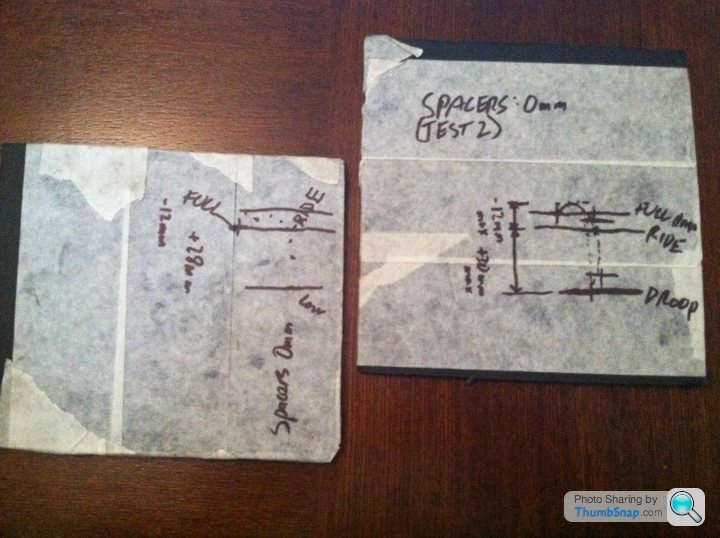
They both showed a bump oversteer of 1.2mm (actual measurement is divided by factor of 10) and a droop from ride height understeer/toeout of 3mm.
My modification of +2 and +4mm spacers under the rack:
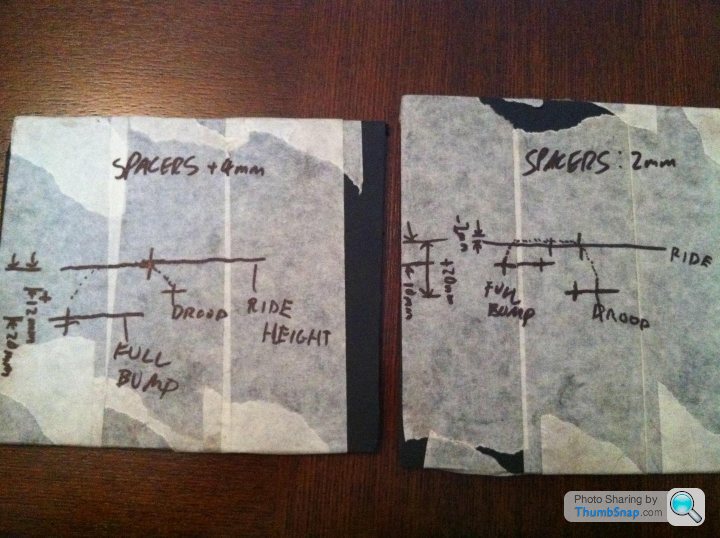
These showed 0mm to 0.2mm of bump oversteer for most of the travel and both showed toe out at the extremes of travel in bump and droop.
My conclusion is that 2mm seems to be the best compromise for my suspension set up.
I would be happier if that at full bump and full suspension droop, that there was less under steer/toeing out of the wheels, but in the grand scheme of things the suspension will spend very little time at those extremes.
As a result, I think I'll stick with the standard suspension components and add 2mm to the rack to raise it upwards. If I can measure the scrub radius and it falls significantly outside the centre line of the wheel, I'll have to consider adding some spacers as before. If that doesn't work, then parhaps the new arms might then make sense? Its not a cheap mod, but it would be worth it for a stable and predicatble cornering car.
I hope this was useful. Please let me know if you have any comments or dissagre with my method and findings. I want to get my car right now, whilst its easy to work on, so if you've had any experience with getting your Tuscan to handle correctly, I'm all ears!
Cheers,
Martin
For anyone wanting to know more about suspension design, I would reccoment reading "The sports car and Kit car suspension and brakes high performance manual". Its hardcore reading and takes a while to sink in. I'd also reccomend getting your hands on a remote controlled buggy so that you can play with the suspension and see the relationships and effects of different settings.
I am in the throws of rebuilding my Tuscan from the ground up:
http://www.pistonheads.com/gassing/topic.asp?h=0&a...
and the latest discussion has moved onto the suspension and whether I should change the design to the later configuration.
The research I have done shows that in march 2001 the design of the front suspension changed in the following way:
- The top wishbones were made longer/wider (pushing the ball joint outboard)

- The upright's top ball joint was moved outboards by circa 10mm
- A couple of different racks were used. The early (dates unknown) Tuscans used the same racks at the Chims, Griffs and the Cerbera V8 cars. (If anyone has more information on the specifics, please let me know).
- There are 2 track rod lengths quoted: 336mm (early cars, dates unknown) and 316mm (late Tuscans/T350 and Tamora).
- The King Pin Inclination was reduced.
- The longer wishbones reduced the dynamic effect on camber (leaning over of the wheel to maintain a square relationship to the road)
- The Scrub/Pivot radius was affected (assumed to have brought it inboard).
Bump steer is often refered to as "The problem with the early cars". From my dealings and involvement with the SP Wheel Spacers (I was the first person to test it), I understand that tyre wall height has an effect on the scrub radius and by either increasing the tyre wall or increasing your offset with a spacer, it is possible to alter the scrub radius.
From what I have read, the scrub radius needs to pass through the contact patch of the tyre and depending on whether it passes inboard or outboard of the centre line of the wheel, it can have an effect of pulling the wheel either outboard or inboard.
Acknowledging the above, if in addition to the scrub radius, there is an effect of bump steer that will cause the wheels to point outwards (positive toe) or inwards (negative toe), the effect can be significantly amplified.
Therefore, I set out to understand suspensions characteristics on MY CAR (Jan 2000). I can only comment on my car due to the aformentioned variables.
I set up my geometry to the following default factory settings:
- -0.7 degrees of negative (Camber)
- Shims either side of the upper ball joint (Castor)
- 1mm of front Toe in
I used this experimental setup/technique to measure bump steer: http://youtu.be/LO07qmJ9zkk
My videos show the standard setup, and with 4mm added beneath the steering rack.
http://youtu.be/3QKvdZWyV_I
http://youtu.be/_Yt0JcNhxOA
From what I understand, the thing to look out for is not to have too much bump oversteer. When there is compression of the outer wheel's suspension in a corner, any bump oversteer (additinal toe in) of the outer wheel, causes the wheel to point into the corner more than you want to/have dialed in with the steering wheel. If this happens you'll be turning in too much, so you'lll have to take off steering lock, which reduces the load on the outer wheel, (reducing the compression), which in turn takes off the bump oversteer, which then means you're not turning in enough, so you have to turn into the corner more...... This leads to an unstable cornering car that for want of a better word, 'weaves' through the corner.
The ideal scenario, is to not have any bump oversteer on the outside wheel, so that the amount you steer in, is the amount you get. Having said that, having bump understeer on the inside wheel, (which is drooping/lower than ride height due to body roll), means the inside wheel turns in more to the corner, which helps/can be beneficial up to a point.
I also tried the experiment with 2mm spacer. This seemed to give the best compromise. The suspension's toe stayed within 0.2mm thoughout 85% of the total travel of the suspension.
Here are the lazer traces:
I did 2 experiments at normal factory settings, one and the begining of the test and one at the end, after the 2mm and 4mm tests. (to validate consistency in my set up)
Factory setup:

They both showed a bump oversteer of 1.2mm (actual measurement is divided by factor of 10) and a droop from ride height understeer/toeout of 3mm.
My modification of +2 and +4mm spacers under the rack:

These showed 0mm to 0.2mm of bump oversteer for most of the travel and both showed toe out at the extremes of travel in bump and droop.
My conclusion is that 2mm seems to be the best compromise for my suspension set up.
I would be happier if that at full bump and full suspension droop, that there was less under steer/toeing out of the wheels, but in the grand scheme of things the suspension will spend very little time at those extremes.
As a result, I think I'll stick with the standard suspension components and add 2mm to the rack to raise it upwards. If I can measure the scrub radius and it falls significantly outside the centre line of the wheel, I'll have to consider adding some spacers as before. If that doesn't work, then parhaps the new arms might then make sense? Its not a cheap mod, but it would be worth it for a stable and predicatble cornering car.
I hope this was useful. Please let me know if you have any comments or dissagre with my method and findings. I want to get my car right now, whilst its easy to work on, so if you've had any experience with getting your Tuscan to handle correctly, I'm all ears!
Cheers,
Martin
It seems to be accepted that the early Tuscans had issues
Bump steer
Tramlining
Twitcheness in high speed corners
This is complicated by the fact there seems to be a number of variables thrown in
Rack length
top ball mounting position on upright
top wishbone length
castor
scrub rad
Ride height
tyre size
Damping rates
spring rate
brake disc thickness (wheel offset)
Also a small change to anyone off these seem to make a big differance to the way the car feels
There are people out there who can get these cars to handle really well
but how much is common knowledge ?
and how many people with good handling cars know what setup they,ve got
Bump steer
Tramlining
Twitcheness in high speed corners
This is complicated by the fact there seems to be a number of variables thrown in
Rack length
top ball mounting position on upright
top wishbone length
castor
scrub rad
Ride height
tyre size
Damping rates
spring rate
brake disc thickness (wheel offset)
Also a small change to anyone off these seem to make a big differance to the way the car feels
There are people out there who can get these cars to handle really well
but how much is common knowledge ?
and how many people with good handling cars know what setup they,ve got
blueg33 said:
Great Martin. That is very useful.
My car is a December 2000, I may start with raising the rack 2mm as you have.
What geo settings have you used after raising the rack?
I'm no expert and the car is still being built. I'd start with the standard settings and work from there.My car is a December 2000, I may start with raising the rack 2mm as you have.
What geo settings have you used after raising the rack?
If the rack was changed in '01 at the same time as the wishbones and the top ball joint, it sounds like it could be an expensive upgrade!!
I thought the changes to the suspension coincided with the launch of the Tuscan S in late '01? At the time it was billed as having revised suspension geometry to account for the 18" spiders that were standard on the S.
The early cars were designed for the 16" spiders which had different offsets. Anyone with a standard early car try it on 16" spiders? How did it handle?
The early cars were designed for the 16" spiders which had different offsets. Anyone with a standard early car try it on 16" spiders? How did it handle?
Basil Brush said:
Mine originally was something like the middle left, although with the combination of the longer tie rod and mismatched angles it wasn't a straight line.
+1 my 2001 car was the sameeven though it was built with the longer top wishbone, longer rack and upright with top balljoint 15mm outboard
it was not a nice car to drive, hence my comments to people rebuilding these cars "sort it out"
Think mine is top left now (but only slightly) a small amount of bump out is not realy noticable(to me) to drive
bump in is not nice
Edited by Walford on Thursday 26th January 21:01
Not Sure if this is correct,Am sure somone will tell me
Wishbone
Part No TVR C0194
up to 2001 major problems KPI/castor issues, and bumpsteer
Wishbone
Part No TVR C0932
2001 to 2002 KPI/castor sorted (rack length change) reduced bumpsteer
Wishbone
Part No TVR C0945
am not sure but maybe these cars have a little more lock, smaller turning circle
Wishbone
Part No TVR C0194
up to 2001 major problems KPI/castor issues, and bumpsteer
Wishbone
Part No TVR C0932
2001 to 2002 KPI/castor sorted (rack length change) reduced bumpsteer
Wishbone
Part No TVR C0945
am not sure but maybe these cars have a little more lock, smaller turning circle
Ken Barlow said:
when did the Tuscan go from 1.7 to 2 turns lock to lock
does this make then less skitish
The increase lock was possible by the top arms being changed slightly, allowing more lock. The rack remained the same but some of the nylon bump stops that prevented the wheels moving to much and clashing with upper wishbone were removed to give the extra throw/steering lock.does this make then less skitish
The 2001 cars had 4 deg less KPI and so could run more castor,(and keep the same feel) this gives more camber as lock is applied
also the straight ahead camber curve is altered by the longer top wishbone and the scrub rad is moved inboard around 25mm (by the KPI change)
add to this rack length and track rod length and most people with the early cars don't want to run 16 inch rims
Bet you wish you,d not posted asking for comments on your rebuild
also the straight ahead camber curve is altered by the longer top wishbone and the scrub rad is moved inboard around 25mm (by the KPI change)
add to this rack length and track rod length and most people with the early cars don't want to run 16 inch rims
Bet you wish you,d not posted asking for comments on your rebuild
i've never measured bad bumpsteer on any tuscan or cerb .. they have a small toe out in bump of less than 0.5 degrees over the (very generous) full travel. I have however measured some horrific aftermarkets kits with as much as 8 whole degrees of toe out in bump! Likewise I've never driven a cerb or early tuscan that wanted to throw me into a ditch like some people report. Is it just that there are a heck of a lot of badly set up cars out there?
Mine was registered in 01 01 so its quite an early car, it is a red rose.
It has gaz gold pro, 10mm of spacers under the rack, as much castor as is possible, toe in on the rear, front wheels are central (no toe) , camber is 1 deg neg front and 1.5 neg on the rear.
225/40/18 front with spacers, 245/40/18 rear.
The car drives well, certainly much much better having a proper geometry set up and the rack spacers, it does still feel a bit nervous on b roads but i think any car which is low,stiff and has even vageuly aggresive geometry will (in my experience any way). It could be better but i'm not sure its worth spending on.
I also find that when suspension is set on the verge of being very stiff it handles and behaves better, i like that though, if i wanted soft i'd drive a family saloon
Tyre pressures i have dropped to 22 all round, i suspect this is a lot to do with the tyres (yoko ad08) as the stiff tyre wall compensates for lack of pressure. 24psi+ genuinely feels too floaty. I may even drop them to 20 when i get the car back and see what thats like.
On track it is VERY good, a bit of a handful but does handle well. It does need to be set to full stiff and drop a couple more psi out the tyres though. Until i did that it was really bad, lots of understeer going into wild oversteer. A simple tweek of the dampers though and tyres made a huge great big difference.
This year i may look at the sag steering arms possibly.
It has gaz gold pro, 10mm of spacers under the rack, as much castor as is possible, toe in on the rear, front wheels are central (no toe) , camber is 1 deg neg front and 1.5 neg on the rear.
225/40/18 front with spacers, 245/40/18 rear.
The car drives well, certainly much much better having a proper geometry set up and the rack spacers, it does still feel a bit nervous on b roads but i think any car which is low,stiff and has even vageuly aggresive geometry will (in my experience any way). It could be better but i'm not sure its worth spending on.
I also find that when suspension is set on the verge of being very stiff it handles and behaves better, i like that though, if i wanted soft i'd drive a family saloon

Tyre pressures i have dropped to 22 all round, i suspect this is a lot to do with the tyres (yoko ad08) as the stiff tyre wall compensates for lack of pressure. 24psi+ genuinely feels too floaty. I may even drop them to 20 when i get the car back and see what thats like.
On track it is VERY good, a bit of a handful but does handle well. It does need to be set to full stiff and drop a couple more psi out the tyres though. Until i did that it was really bad, lots of understeer going into wild oversteer. A simple tweek of the dampers though and tyres made a huge great big difference.
This year i may look at the sag steering arms possibly.
spitfire4v8 said:
i've never measured bad bumpsteer on any tuscan or cerb .. they have a small toe out in bump of less than 0.5 degrees over the (very generous) full travel. I have however measured some horrific aftermarkets kits with as much as 8 whole degrees of toe out in bump! Likewise I've never driven a cerb or early tuscan that wanted to throw me into a ditch like some people report. Is it just that there are a heck of a lot of badly set up cars out there?
My Car had massive bump steer, not sure how "Bad Set up" would caurse thisand what part of "Good Set up" would cure it
Seems to me that updated parts were introduced by TVR over 18 months or so, also cars get parts replaced as the years pass by
Just trying to get as much info about the front end on the forum as posible
what aftermarket parts have you come across, that give big problems
Gob smacked reading this.... the single biggest improvement (IMHO) that can be made over the standard set up is replacing the Bilstein dampers... I went for the tried, tested and proven Nitrons and the difference... well lets say the earth moved for me n my TIV. Stability at high speed, cornering and standing starts - awesome, cars handling is beyond my capabilities. I am however, intriuged by the authors intent on experimentations... Is the car being set up for track days, or racing?
Gassing Station | Tuscan | Top of Page | What's New | My Stuff




